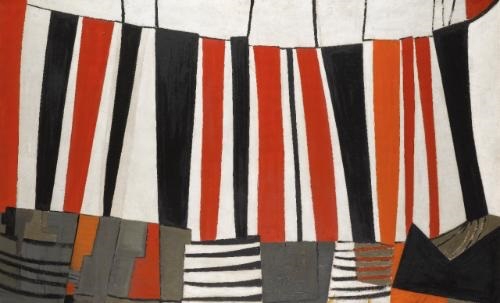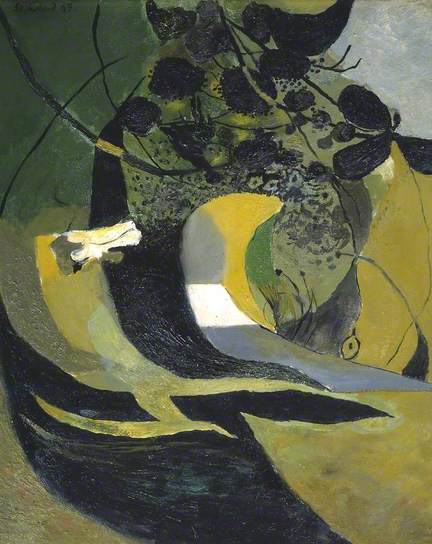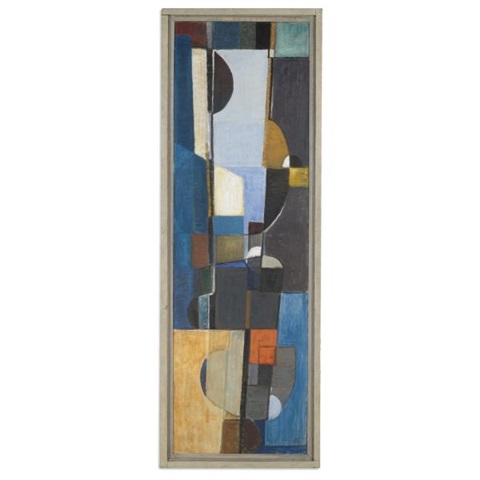
The two locations for this exhibition, Yorkshire and Cornwall, couldn't be more apt as places to see and experience the work of Terry Frost. Both places were close to his heart, and both places brought to bear huge influence on the development of his painting. I have thus chosen two paintings by Frost, one each from Cornwall and Yorkshire, which I find perfectly illustrate why he was an artist whose place in British art of the 1950s we should, in this his centenary year, celebrate.

Whilst there had been a small but thriving modernist movement in Britain in the decade prior to the outbreak of WWII, it was hardly surprising that the privations of the war years had seen a shift in artistic trends. Of necessity isolated during the war, the works of artists such as John Piper, John Minton and Graham Sutherland (see Entrance to a Lane, 1939, Tate Britain) typified the growth of what we now term neo-romantic tendencies, much involved with a brooding, introspective nostalgia, and their crepuscular images of town and landscape exude a sense of ingrained Britishness that was perhaps essential to the preservation of national identity in the face of such great threat to the nation.
Even those artists most closely identified with the modern movement of the 1930s, such as Henry Moore, Ben Nicholson and Barbara Hepworth, had demonstrated a shift in their works away from pure abstraction and had brought both figure and landscape references into their work. However, as the country emerged from the war, the sense of opportunity to build a new future, most obviously seen in the massive Labour landslide in the 1945 election rejecting the magisterial war-leader Churchill, materialised in every walk of life. The position and function of the arts in this renewed Britain was much debated, and with the scale of rebuilding that was necessary, the opportunities for the involvement of the arts in this brave new world were much lauded.
For the artists themselves, the paths that lay before them were varied. The example of European modernism was still fresh in the minds of many, and indeed in the work of both Hepworth and Nicholson we see the development of a landscape-inspired abstraction that was to typify one major path. As two senior and established figures in the British art world, their move to Cornwall in 1939 had contributed to the significant position that came to be held by the small fishing town of St.Ives, and as the 1940s drew to a close, it already boasted a large number of artists who held considerable reputations nationally, and would soon start to be increasingly recognised abroad.

Frost had moved to St.Ives in 1946 after demobilisation, and thus had immediately found himself immersed in one of the key forums for abstracted art in Britain in the immediate post-war period. Always gregarious, he very quickly struck up friendships with many of his contemporaries and his recollections tell us a good deal about the collective aims of this group. However, Frost’s route to art had not come from pre-war study, or time in a Parisian atelier, but through his meeting with Adrian Heath in a prisoner of war camp. A former Slade School student, Heath encouraged Frost to follow his incipient interest, and with an ex-serviceman’s grant, Frost was accepted to study at Camberwell School of Art (his family remained in Cornwall and he returned there whenever possible). Camberwell gave Frost exposure to another strand of artistic thought, most notably through the work of Victor Pasmore. Like the St.Ives artists, Pasmore was also treading a path that was drawing increasingly abstracted imagery from natural subject matter. However, whilst the St.Ives tendency was to take an instinctive route to such abstraction, many of the artists associated with Camberwell were becoming increasingly interested in the theoretical aspects of composition. Pasmore himself was very much concerned with the theories surrounding harmonious proportion and the Golden Section (see Triangular Motif, c1949, Ferens Art Gallery, Hull), as was his and Frost’s mutual friend Heath, whose own move towards abstraction in the 1948-49 must have been a strong example for Frost.
The group that was forming loosely around Heath and Pasmore (generally known these days as the Fitzroy Group) felt themselves to be in the avant-garde of a new and pioneering art. Opportunities for first-hand exposure to works by the ground-breaking continental abstract artists of the 1920’s and 1930’s were rare indeed in Britain for some time after WWII, and thus the artists returned to the writings of both those creators and theorists who had inspired their predecessors. Essays by Mondrian, Vantongerloo, Arp and Kandinsky were eagerly read, as were the works of the theorists, such as J.W.Power and Jay Hambidge. Pasmore and Heath’s early work was particularly influenced by the writings of both, and developed a compositional system whereby units that were proportionally related to the overall dimensions of the support were moved and rotated to create the underlying constructed composition over which the artist was able to make his own aesthetic decisions.

This simultaneous exposure to, and friendships within, the two major emerging strands of British abstraction were key to establishing the unique position that is held by Frost’s art at this time. The development of a theoretical underpinning to his painting can be seen in what must rank as Frost’s first mature abstract painting, Madrigal of 1949 (Leamington Spa Art Gallery), but this does not entirely sit easily with the expressiveness of the source material, W.H.Auden’s poem of the same title.
A more resolved painting of later the same year, and thus after Frost’s return to Cornwall, was Mullion Cove (whereabouts unknown), which the artist recalled resulted from a drawing trip taken with Peter Lanyon. Lanyon’s physical involvement with the landscape was a key feature of the direction his painting was taking, and which he shared with his friend;
‘Peter would drive me all over the place, along the coast and up on the moors…he taught me to experience landscape…so that you knew what was above and below you, and what was above and below the forms you were going to draw…
Peter…was so expressionistic while I was very tight-arsed because of Camberwell. He just roared into his drawing…I would get out my geometrical divisions and then find a way to express something like Mullion Cove…until I rediscovered my experience’ (the artist, interview with David Lewis, December 1991 & October 1993)

This sense of using two apparently contradictory approaches to create his art was clearly not easy for Frost, but in Walk Along the Quay(Private Collection), painted in 1950 and a work that would subsequ ently be seen as career-defining, he brought them together perfectly to create a work which still has power and immediacy over six decades after it was painted. Although not the earliest of his group of paintings of similar titles, the artist's success in achieving his aims was recognised immediately. Frost had sought a visual language which would express the sense of place and movement found in the harbour of St.Ives in an abstract idiom. Derived in part from his experience of early morning walks through the town, the painting uses extremely sophisticated geometrical and colour relationships to suggest familiar forms and shapes whilst never actually offering us pictorially identifiable references.
‘I never thought about it at the time, I thought of the title after I got the idea, I mean I had been walking along the quay every morning…it was quite a simple experience. I just happened to notice that the boats were there with a different colour on when the tide was out and they were all propped up and there I saw all those semi-circles propped up on a stick…the strange feeling of looking on top of boats at high tide and the same boats tied up and resting…when the tide’s out. The size of canvas was suggested to me by one I happened to have. It had to conform to my idea, the walk, so it was long, like the quay (the pier past Smeaton’s Lighthouse) and narrow…in fact I just walked up the canvas in paint’ (the artist, transcript of conversation with Adrian Heath and John Hoskin, July 1987)
Frost’s painting in the early 1950s thus sits at the very centre of the debate between the experience-influenced abstracted images of the St.Ives painters and the rigorously constructivist work of the artists of the Fitzroy Group and they therefore have a crucial place in British abstract art of the immediate post-war period. As the key painting of this phase of his work, we can therefore see Walk Along the Quay as a work which was perhaps the first fully resolved statement of the approach to painting which Frost would adhere to for the next five decades. However, if we accept that Frost’s simultaneous involvement at this time in both major groups at the avant-garde of British abstraction is unique, then Walk Along the Quay becomes a unique statement in British art of the time, a beacon of the concerns that would see British art achieving world recognition in the years that followed.
Whilst Walk Along the Quay perfectly encapsulates the way in which the Cornish environment informed Frost's early paintings, his next phase was very much influenced by his time in Yorkshire. This came about as a result of his being appointed Gregory Fellow in Painting at Leeds University in 1954 and his move to the city.
The institution of the Gregory Fellowships at Leeds University by E.C. ‘Peter’ Gregory in 1950 was a remarkably prescient piece of private patronage. The novel idea of instituting positions that would bring leading artists, sculptors, poets and musicians into the city was remarkably successful, and was seen as a positive experience for both the artistic and academic life of Leeds and the fellows themselves. With his characteristic gusto, Frost threw himself into the post, and the cross-pollination of ideas with other institutions was responsible for awakening an interest in contemporary art in many who were later to become important supporters of his work. In his essay ‘The Leeds Connection’ (published in David Lewis, Terry Frost, Aldershot 1994, pp.62-7) one of these, Ronnie Duncan, wrote a memorable account of Frost’s involvement in this artistic environment of Leeds, but he also identifies the very important place in the development of Frost's art that is held by the paintings from this period. Frost had responded well to the expansiveness of the Yorkshire landscape, and the characteristic colours and forms that began to appear within a relatively short time of his arrival in Leeds created images that are very definitely distinct from his Cornish work.

Frost realised that his work was reacting to the Yorkshire landscape in a very different way from that in Cornwall, and both the forms and the palette of these paintings show significant development from his earlier works. His sense of being much more involved in, and dwarfed by, a landscape began to become more evident and the compositions take on a much more panoramic feel. Red, Black and White, Leeds, 1955 (Private Collection) is one of the best known examples of a group of important paintings that mark this new period of inspiration. The intricate interlocking forms of the St.Ives paintings have become much less of a central element in the composition and shift towards the edges of the image, being replaced by a pronounced vertical emphasis which may derive from the patterns of stone walls running along hillside fields in the Yorkshire landscape. Frost's excitement at his new environment is clear in his letters of the time, and also in his later recollections of the years in Leeds.
'Being in a vast cape of white and cold but brilliant space, the sharp air and smooth folds of white snow resting in fields, hanging on black lines... Walking was good because I went down and the white came up all around and yet it never touched me, so I was a black thing in a funnel of white with no space that I knew. I could not touch the sides, the space and the silence went with me as I walked, and I was so small.' (The Artist, interview with David Lewis, July 1993)
For me, these two paintings, Walk Along the Quay and Red, Black and White, Leeds, 1955, tell us so much about not just Frost's art, but the aims and aspirations of many artists in Britain in the decades after WWII. Seeking to draw essential forms and colours from the landscape and the objects around them, they produced paintings and sculptures which aimed to get inside the subject and show us, without resorting to unnecessary detail and narrative, the essence of those nebulous but nevertheless important sensations we experience every day and all around us.
The fact we still find many of their works expressive and successful today suggests that a lot of the time, at least, they were getting it right.